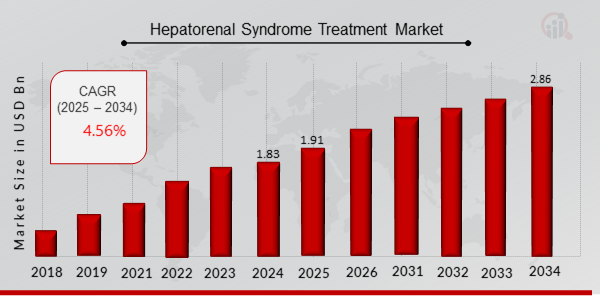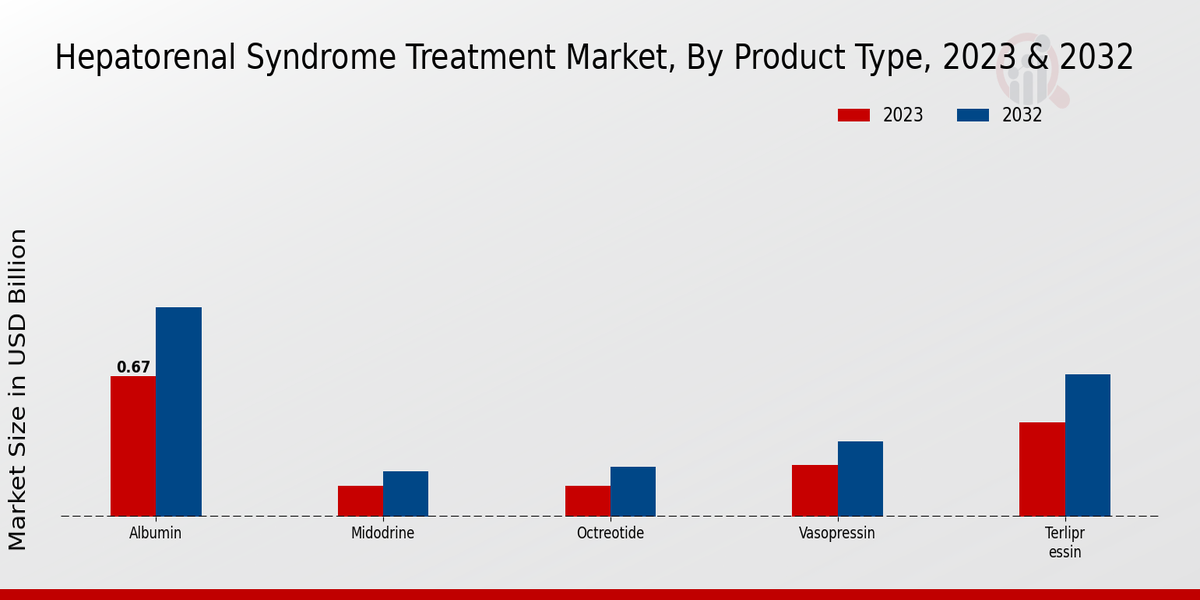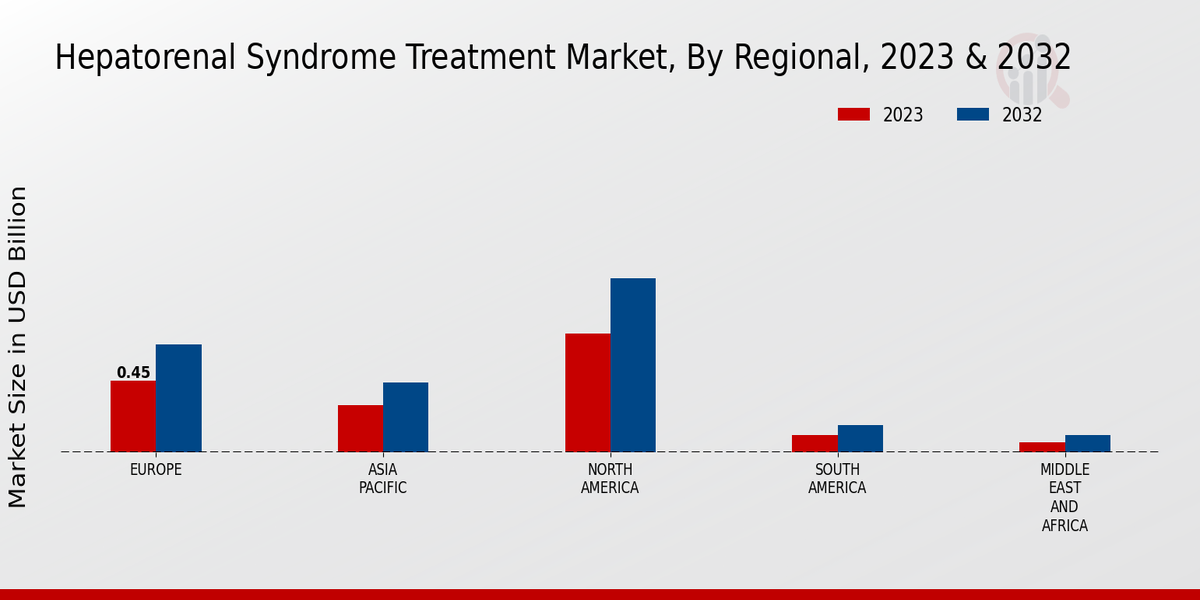Hepatorenal Syndrome Treatment Market Overview
As per MRFR analysis, the Hepatorenal Syndrome Treatment Market Size was estimated at 1.83 (USD Billion) in 2024. The Hepatorenal Syndrome Treatment Market Industry is expected to grow from 1.91 (USD Billion) in 2025 to 2.86 (USD Billion) till 2034, at a CAGR (growth rate) is expected to be around 4.56% during the forecast period (2025 - 2034).
Key Hepatorenal Syndrome Treatment Market Trends Highlighted
Hepatorenal Syndrome Treatment Market is anticipated to surge in upcoming years due to multiple factors. Rising burden of chronic liver diseases, especially cirrhosis, and associated complications like hepatorenal syndrome, drive market growth.
Additionally, increasing awareness of hepatorenal syndrome, technological advancements in treatment options, and the unmet medical need for effective therapies are shaping market dynamics.
Opportunities for market growth lie in the exploration of novel therapies, including non-invasive and targeted treatment approaches. Current trends in the market point towards the development of synthetic human albumin, artificial liver devices, and gene therapies, offering potential breakthroughs in hepatorenal syndrome management.
Furthermore, the increasing prevalence of liver diseases in developing regions, coupled with growing healthcare infrastructure and disposable income, presents significant opportunities for market expansion. Collaboration between industry stakeholders, research institutions, and healthcare providers is crucial to fuel innovation and enhance access to treatment.

Source: Primary Research, Secondary Research, MRFR Database and Analyst Review
Hepatorenal Syndrome Treatment Market Drivers
Rising Prevalence of Chronic Liver Disease
Chronic liver disease, such as cirrhosis, is a major risk factor for developing hepatorenal syndrome. The increasing prevalence of chronic liver disease is primarily attributed to factors such as the growing incidence of viral hepatitis, non-alcoholic fatty liver disease, and alcohol abuse.
As the number of individuals with chronic liver disease rises, the demand for hepatorenal syndrome treatment is expected to increase in parallel. The Hepatorenal Syndrome Treatment Market is projected to grow significantly in the coming years due to the high prevalence of chronic liver disease worldwide.
Technological Advancements in Treatment Options
The development of medical technologies has been the main driver of new and more effective methods of treatment, which are offered to patients with hepatorenal syndrome.
Nowadays, there are modern medications and dialysis alternatives, such as vasopressin antagonists and albumin, which are more effective and less risky than traditional kidney transplant. Modern treatments have also ensured better patient outcomes and increased demand for hepatorenal syndrome treatment.
Increasing Awareness and Improved Diagnosis
Growing awareness about hepatorenal syndrome among healthcare professionals and patients has contributed to its timely diagnosis and management.
Educational campaigns and initiatives have played a crucial role in disseminating information about the condition, its symptoms, and the importance of early intervention. As a result, more patients are being diagnosed with hepatorenal syndrome, leading to increased demand for treatment.
Hepatorenal Syndrome Treatment Market Segment Insights:
Hepatorenal Syndrome Treatment Market Product Type Insights
The Hepatorenal Syndrome Treatment Market is experiencing notable growth driven by its diverse Product Type segmentation.
Within this segmentation, Albumin commanded a significant market presence, valued at 0.67 USD Billion in 2023 and projected to reach 1.0 USD Billion by 2032. This prominent position emphasized its critical role in treating patients with hepatorenal syndrome, owing to its effectiveness in stabilizing circulatory volume and improving kidney function.
Terlipressin, holding a value of 0.45 USD Billion, was another essential product in this realm, expected to grow to 0.68 USD Billion by 2032, highlighting its effectiveness in managing acute kidney injury related to liver disease.
Vasopressin, valued at 0.25 USD Billion, remained a significant contributor, focusing on its action to reduce renal vascular resistance, though it may have a smaller share compared to others.
Midodrine and Octreotide, each with a valuation of 0.15 USD Billion in 2023, also held importance due to their unique mechanisms aimed at increasing blood pressure and managing symptoms related to hepatic disorders. The collective market performance of these Product Types showcases varied treatment avenues available for healthcare providers addressing this condition.
In addition, the market landscape includes Spironolactone and Furosemide, which target fluid retention and hypertension, both critical in managing the symptoms of hepatic dysfunction. The "Other Drugs" category, while less dominant, indicates a range of therapies that complement the primary treatments, enabling customized patient management strategies.
The growing prevalence of liver-related diseases and advanced healthcare research aimed at improving therapeutic outcomes further propels the growth of the Hepatorenal Syndrome Treatment Market. Leveraging these insights, stakeholders can focus on key drivers such as innovation in drug formulations and enhanced delivery systems to meet the evolving demands in this vital therapeutic area.
The statistics highlight the potential for substantial market growth, indicating a strong interest in expanding treatment offerings that cater to the varied needs of patients suffering from hepatorenal syndrome.

Source: Primary Research, Secondary Research, MRFR Database and Analyst Review
Hepatorenal Syndrome Treatment Market Indication Insights
The segmentation of this market by indication has become increasingly significant, with Type 1 and Type 2 Hepatorenal Syndrome showcasing considerable prevalence. Type 1 Hepatorenal Syndrome is often associated with a rapid decline in kidney function and commonly arises in patients with acute liver failure, making the demand for effective treatment critical.
Type 2 Hepatorenal Syndrome, characterized by a more gradual decline, also holds a substantial share due to its chronic nature and association with decompensated cirrhosis, which continues to be a leading cause of morbidity.
Other indications related to liver complications also present opportunities within this market, signaling a comprehensive approach toward treatment. The Hepatorenal Syndrome Treatment Market data reflects how increasing awareness and improved diagnostic methods are driving growth, with relevant statistics supporting these trends.
The rise in cases of liver diseases creates persistent challenges, enhancing the need for innovative therapeutic solutions and thus shaping the dynamics of this market
Hepatorenal Syndrome Treatment Market Route of Administration Insights
The Hepatorenal Syndrome Treatment Market exhibits a diverse Route of Administration that plays a crucial role in treatment efficacy and patient compliance. The major routes encompass Intravenous, Oral, and Subcutaneous administration, each contributing differently to the overall market dynamics.
Intravenous administration is often favored for its ability to provide rapid therapeutic effects, particularly in critical care settings. Oral administration ensures ease of use and compliance, making it a popular choice among patients.
Meanwhile, Subcutaneous methods are increasingly recognized for their convenience and potential for self-administration, catering to a growing preference for at-home treatment options.
The Hepatorenal Syndrome Treatment Market statistics reflect a steady growth trend influenced by advancements in formulation technologies and increased awareness about Hepatorenal Syndrome, presenting significant opportunities for industry players.
As patient-centric care continues to gain momentum, the emphasis on optimizing the Route of Administration remains a vital aspect, driving innovation and improving patient outcomes in the Hepatorenal Syndrome Treatment Market.
Hepatorenal Syndrome Treatment Market Distribution Channel Insights
The Hepatorenal Syndrome Treatment Market showcases a diverse distribution landscape characterized by various channels that contribute to market accessibility.
Among these, hospital pharmacies play a crucial role due to their proximity to healthcare settings, facilitating the prompt dispensation of treatments and ensuring adherence to complex therapy regimens for patients suffering from Hepatorenal Syndrome.
Retail pharmacies also hold a significant position, as they cater to a large portion of the population seeking over-the-counter and prescription medications, thus enhancing the market's outreach in community settings.
The rise of online pharmacies has further transformed the distribution channel, offering convenience and privacy while catering to a growing number of patients who prefer home delivery options.
These shifts indicate broader market growth trends as healthcare continues to evolve towards more patient-centered approaches, highlighting opportunities in distribution efficiencies, accessibility, and consumer preferences within the Hepatorenal Syndrome Treatment Market revenue landscape.
As the market progresses, ongoing developments in regulation and technology will shape the dynamics of these distribution channels, driving stronger market segmentation and offering new growth possibilities.
Hepatorenal Syndrome Treatment Market Patient Population Insights
Within this market, conditions such as severe liver disease and decompensated cirrhosis play a crucial role, as they represent a significant portion of the patient demographic, often leading to acute renal failure. Hepatic encephalopathy and ascites further contribute to the complexity of treatment, necessitating advanced management strategies.
Additionally, end-stage liver disease poses considerable challenges, as this critical condition often results in a high degree of comorbidity, emphasizing the need for specialized treatment options.
As such, the growing awareness of these conditions and the importance of early intervention is shaping the landscape of the Hepatorenal Syndrome Treatment Market, driving research and development efforts while addressing patient needs more effectively.
The segmentation within this market reflects the diverse range of challenges faced by healthcare providers in managing these interconnected liver and kidney-related conditions.
Hepatorenal Syndrome Treatment Market Regional Insights
North America led with a valuation of 0.75 USD Billion and is expected to reach 1.1 USD Billion by 2032, indicating a significant market growth driven by advanced healthcare infrastructure and high treatment awareness.
Europe followed with a market size of 0.45 USD Billion in 2023 and is projected to grow to 0.68 USD Billion, demonstrating a strong emphasis on innovative therapeutic solutions. South America, although smaller in scale at 0.11 USD Billion initially and 0.17 USD Billion later, revealed potential for expansion owing to rising healthcare investments.
In the Asia Pacific region, the market stood at 0.3 USD Billion and is anticipated to grow to 0.44 USD Billion, signifying a growing patient population and increasing access to treatment options.
Lastly, the Middle East and Africa represented the smallest share with a valuation of 0.06 USD Billion in 2023, reflecting challenges in healthcare systems but also opportunities for market players to enhance treatment availability.
Together, these regional dynamics shape the overall Hepatorenal Syndrome Treatment Market landscape, highlighting the varying growth trajectories and healthcare priorities across different geographies.

Source: Primary Research, Secondary Research, MRFR Database and Analyst Review
Hepatorenal Syndrome Treatment Market Key Players And Competitive Insights:
Major players in the Hepatorenal Syndrome Treatment Market are constantly striving to develop innovative therapies and enhance existing treatments to improve patient outcomes. Continuous research and development activities, combined with strategic partnerships and collaborations, drive the competitive landscape.
Leading Hepatorenal Syndrome Treatment Market players focus on expanding their global presence through acquisitions and partnerships to cater to the growing patient population worldwide. The competitive landscape remains dynamic with the entry of new players and the consolidation of existing ones through mergers and acquisitions.
Astellas Pharma Inc., a leading player in the Hepatorenal Syndrome Treatment Market, is committed to providing innovative and effective therapies for patients with liver diseases. The company's dedication to research and development has resulted in the development of novel treatments, such as roxadustat, which has shown promising results in clinical trials.
Astellas Pharma Inc.'s strong financial position and global reach allow it to invest heavily in research and development and expand its product portfolio. The company's focus on patient-centricity and collaboration with healthcare professionals further enhances its competitive edge.
Fresenius Medical Care, another major player in the Hepatorenal Syndrome Treatment Market, specializes in providing dialysis and renal care products and services. The company's extensive global presence and established distribution network enable it to reach a large patient population.
Fresenius Medical Care focuses on developing innovative dialysis technologies and expanding its product offerings to meet the evolving needs of patients with kidney and liver diseases.
The company's commitment to quality and patient safety, coupled with its strong financial performance, positions it as a formidable competitor in the market. Fresenius Medical Care's strategic partnerships and acquisitions further contribute to its competitive advantage.
Key Companies in the Hepatorenal Syndrome Treatment Market Include:
- Baxter International Inc.
- Bristol-Myers Squibb Company
- Otsuka Holdings Co., Ltd.
- Fresenius Medical Care AG Co. KGaA
Hepatorenal Syndrome Treatment Market Developments
The rising prevalence of chronic liver disease, increasing demand for liver transplantation, and growing awareness of hepatorenal syndrome are key factors driving market growth.
Recent advancements in treatment options, such as the development of new drugs and therapies, are also contributing to market expansion. Additionally, government initiatives and support for research and development activities are expected to further drive market growth in the coming years.
Hepatorenal Syndrome Treatment Market Segmentation Insights
-
Hepatorenal Syndrome Treatment Market Product Type Outlook
-
Hepatorenal Syndrome Treatment Market Indication Outlook
- Type 1 Hepatorenal Syndrome
- Type 2 Hepatorenal Syndrome
-
Hepatorenal Syndrome Treatment Market Route of Administration Outlook
-
Hepatorenal Syndrome Treatment Market Distribution Channel Outlook
-
Hepatorenal Syndrome Treatment Market Patient Population Outlook
-
Hepatorenal Syndrome Treatment Market Regional Outlook
| Report Attribute/Metric |
Details |
|
Market Size 2024
|
1.83 (USD Billion)
|
|
Market Size 2025
|
1.91 (USD Billion)
|
|
Market Size 2034
|
2.86 (USD Billion)
|
|
Compound Annual Growth Rate (CAGR)
|
4.56 % (2025 - 2034)
|
|
Report Coverage
|
Revenue Forecast, Competitive Landscape, Growth Factors, and Trends
|
|
Base Year
|
2024
|
|
Market Forecast Period
|
2025 - 2034
|
|
Historical Data
|
2020 - 2024
|
| Market Forecast Units |
USD Billion |
| Key Companies Profiled |
Merck Co., Inc., Baxter International Inc., Asahi Kasei Corporation, Bristol-Myers Squibb Company, Roche Holding AG, Otsuka Holdings Co., Ltd., Terumo Corporation, Celgene Corporation, Sanofi S.A., Medtronic plc, Bayer AG, Novartis AG, Fresenius Medical Care AG Co. KGaA, Eli Lilly and Company, Pfizer Inc. |
| Segments Covered |
Product Type, Indication, Route of Administration, Distribution Channel, Patient Population, Regional |
| Key Market Opportunities |
Trailing edge therapies Personalized treatment plans Telemedicine platforms AIpowered diagnostics Minimally invasive procedures. |
| Key Market Dynamics |
Rising prevalence of chronic liver diseases Increasing demand for early diagnosis Technological advancements Growing awareness of new treatment options Expanding healthcare infrastructure |
| Countries Covered |
North America, Europe, APAC, South America, MEA |
Frequently Asked Questions (FAQ) :
The Hepatorenal Syndrome Treatment Market is projected to be valued at approximately 1.71 USD Billion in 2024.
The market is expected to reach a value of 2.86 USD Billion by 2034.
The market is anticipated to have a CAGR of 4.56% from 2025 to 2034.
North America held the largest market share, valued at 0.75 USD Billion in 2023.
The market in Europe was valued at 0.45 USD Billion in 2023.
Albumin is projected to reach a market value of 1.0 USD Billion by 2032.
Major players include Merck Co., Baxter International, and Roche Holding, among others.
By 2032, the market value of Terlipressin is estimated to be 0.68 USD Billion.
Emerging trends and increasing awareness about treatment solutions present significant growth opportunities.
The South American market is projected to be valued at 0.17 USD Billion by 2032.

















